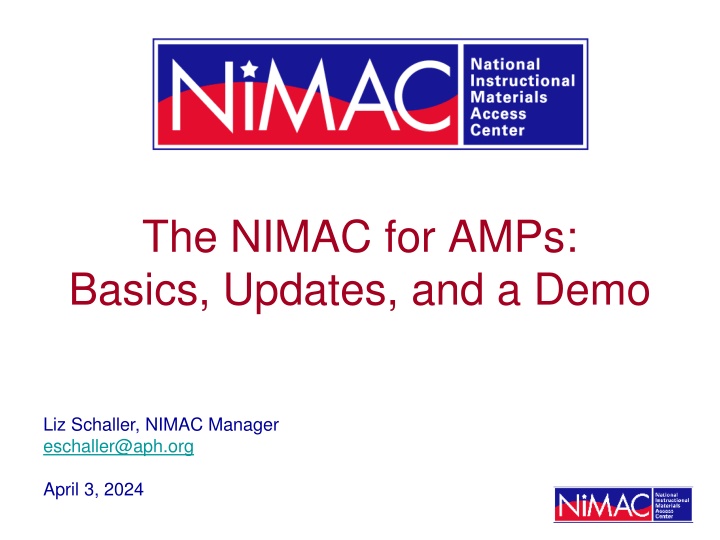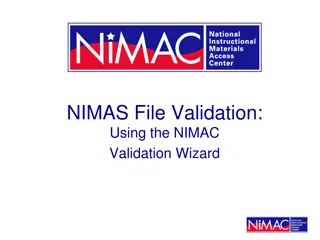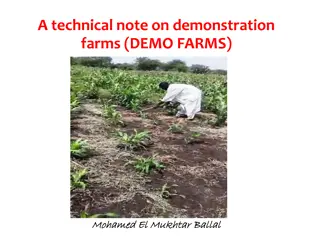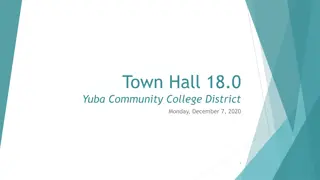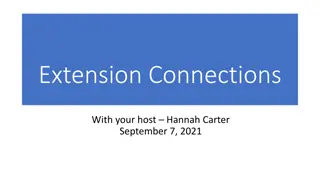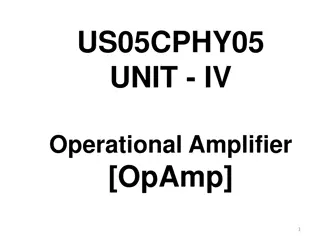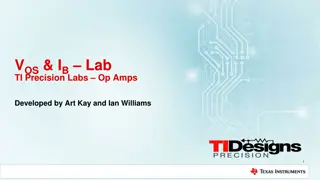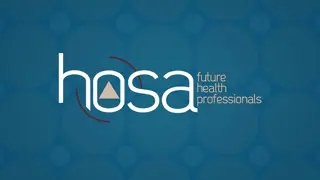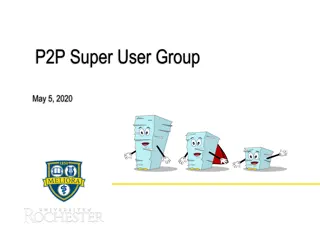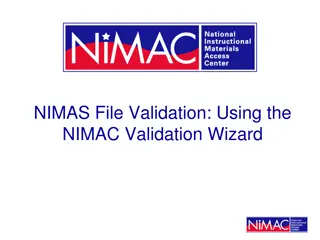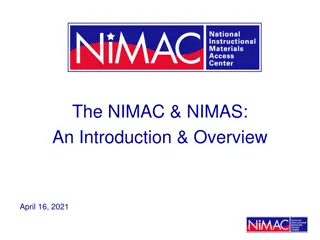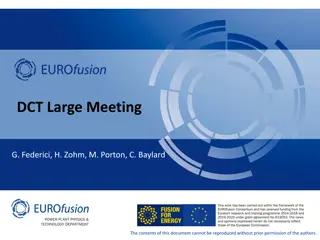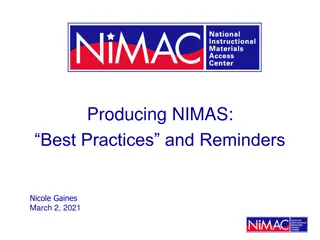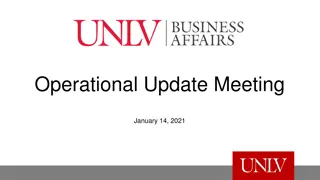Overview of NIMAC for AMPs: Basics, Updates, and Demo
The NIMAC (National Instructional Materials Accessibility Center) serves as the national source file repository for K-12 textbooks and instructional materials. Created in 2004 under IDEA, NIMAC provides NIMAS (National Instructional Materials Accessibility Standard) files for producing accessible formats such as braille, DAISY, EPUB, and large print. Learn about NIMAS, file acquisition mechanisms, types of materials received, and the role of Authorized Users in this comprehensive guide.
Download Presentation

Please find below an Image/Link to download the presentation.
The content on the website is provided AS IS for your information and personal use only. It may not be sold, licensed, or shared on other websites without obtaining consent from the author.If you encounter any issues during the download, it is possible that the publisher has removed the file from their server.
You are allowed to download the files provided on this website for personal or commercial use, subject to the condition that they are used lawfully. All files are the property of their respective owners.
The content on the website is provided AS IS for your information and personal use only. It may not be sold, licensed, or shared on other websites without obtaining consent from the author.
E N D
Presentation Transcript
The NIMAC for AMPs: Basics, Updates, and a Demo Liz Schaller, NIMAC Manager eschaller@aph.org April 3, 2024
Todays Webinar Part 1: PowerPoint NIMAC Basics and File Assignments Policy Updates Services & System Features for AMPs Part 2: Live Demo! Your Account Information & Sub Users Publisher Contact Information Reports Using the Watchlist Downloading & Managing File Assignments Searching
The NIMAC Project Created by IDEA 2004, the NIMAC is the national source file repository for K-12 textbooks and instructional materials. We make NIMAS files available for use in producing accessible formats for K-12 instructional materials. We have over 76,000 file sets from over 180 publishers. All 50 states plus 6 outlying areas and the DoDEA work with the NIMAC.
What is NIMAS? NIMAS is the National Instructional Materials Accessibility Standard. An XML-based source file format. Designed for use in producing formats such as braille, DAISY, EPUB, large print. It is not intended for distribution directly to students. NIMAS is the only format we receive. NIMAS is not a by-product of print or digital book production it can take up to six weeks or more for NIMAS to be produced.
How we get files Under IDEA 2004, the only mechanism to require NIMAS from the publisher is the book adoption contract or purchase agreement. There is no blanket requirement for publishers to submit files to the NIMAC. States and districts have been able to require NIMAS when they purchase new textbooks since 2006. Ideally, when NIMAS is included in contracts, a file will already be available when a need is identified.
Types of materials we receive NIMAC receives a wide range of student- facing instructional materials. These include textbooks, workbooks, supplementary readers, and ancillary materials such as blackline masters. Exempt materials include teacher s editions, pre-2006 titles, trade books, college textbooks, reference books. We can also now accept NIMAS files for some digital instructional materials.
What is an Authorized User? An Authorized User is someone who has been designated by their State Coordinator to have an account that provides full access to the NIMAC repository. They can search and download files or assign files to registered Accessible Media Producers (AMPs). These individuals are generally from within the educational structure of the state, such as from an IRC or state department of education.
What is an AMP account? An Accessible Media Producer (AMP) account allows the user to download any file assigned to them by an Authorized User. These accounts are freely available to any organization or individual who can work with NIMAS to produce accessible formats for K-12 students with print disabilities. These users do not have to be designated by a state coordinator, but they have more limited access to download files.
Should I be an AU? If you need direct access to download files from the system, it may be appropriate for you to be designated as an Authorized User for a given state. To become an AU, you need to be a part of the educational structure of the state, or a non-profit that qualifies as an authorized entity under Chafee. Feel free to contact the NIMAC if you have questions or would like more information.
Side Note: the APH AMP Directory AMP information in the NIMAC is not public. AUs can only access information about AMPs through their NIMAC accounts. If you are interested in sharing information publicly about the services you offer, we invite you to participate in the Accessible Media Producers Directory. This searchable online directory is a free service of APH (separate from the NIMAC). Contact resource@aph.org for more information!
File Assignment Once you have an active AMP account, any Authorized User in any state can assign you files for download. If you are working on a project for a state or district and need help locating an AU in that state to assign you the NIMAS file, just let us know.
Email Notification Whenever you are assigned a file by an Authorized User, the system will send an automated email to let you know that the file is available for download in your queue. The notification will let you know what item has been assigned, what accessible format is being requested, and what user made the assignment.
Spam Filter Heads Up All automated emails from the NIMAC will show as the sender noreply-NIMAC@overdrive.com. Some email systems will filter out automated emails unless you whitelist the sender. If you encounter any issues receiving emails, please add this address to your contacts. You may need to get help from your IT administrator if network restrictions prevent system emails from getting through. Contact the NIMAC for further assistance.
Updating Format Capabilities Format capabilities are selected when a new AMP registers with the NIMAC. They can be viewed and updated at any time by going to User Information My Account. Format information is provided as a convenience for AMPs and the Authorized Users who are assigning them files. Formats should be updated whenever needed to reflect changes in what you produce.
Current Format Capability Options Audio DAISY Audio DAISY Text Digital Braille - UEB Digital Braille - UEB with Nemeth Embossed Braille - UEB Embossed Braille - UEB with Nemeth Large Print PDF EPUB Other
New NLS Guidelines In February of 2021, the National Library Service for the Blind and Print Disabled (NLS) updated its eligibility guidelines. Changes to the guidelines included expanding the pool of professionals who can certify eligibility and eliminating the requirement that a medical doctor certify eligibility for individuals with reading disabilities. Since IDEA 2004 points to the NLS guidelines for NIMAS, these changes also affected the NIMAC.
Updated NIMAC Limitation of Use Agreement To align our agreements with the new NLS guidelines, the NIMAC sent out updated Limitation of Use Agreements (LUAs) to all users in 2021. If you haven t completed a LUA since May 2021, please download the LUA, initial each page, and fill in section 14.0. If you aren t sure if you ve submitted an updated LUA or not, please reach out.
NIMAS Specification Updates The NIMAS specification is defined in the IDEA regs and updating it requires regulatory or legislative action. It was originally intended to be an evolving specification, but IDEA is many years behind schedule for reauthorization. This year, we received a supplemental award from OSEP to explore possible updates to the specification.
Gathering Input for Formal Recommendations The gathering of stakeholder input involves surveys, focus groups, and an in-person NIMAS convening in DC this May. This process will result in a report to OSEP with the NIMAC s recommendations. The Department may then initiate a formal process to update the specification. The NIMAC will also use what is learned in this process to develop additional resources for publishers and NIMAC users.
System Features and Services for AMPs
The Watchlist Research & Expedite Service If a file you need is not available in the NIMAC, you probably will not have a way to know if it should be in the NIMAC or not. AMP accounts now have a built-in system feature where you can add the ISBN to your Watchlist. NIMAC will research the item for you and try to obtain NIMAS for the title.
Watchlist Research If the title is within scope for NIMAS (i.e., not in an exempt category), we will request the file from the publisher. If the file is already in production, we may be able to expedite it for you. When the Watchlist ISBN is available in the NIMAC, you will receive an automated email to let you know. If the file is outside of scope, we will research other accessibility alternatives and provide that information to you.
MathML and NIMAS MathML is optional XML markup for math and scientific notation. The benefit of MathML is that, when software supports it, it can be used to automatically generate braille or other formats. In the past, math was most often provided in NIMAS as images, which cannot automatically be converted into braille.
No MathML Download Many publishers now provide MathML in their NIMAS files--however, not all software supports MathML. If a NIMAS file includes MathML, but your software does not support MathML, you can choose to download the file without MathML. We will show you this download option during the demo.
Does the file include MathML? The NIMAC system will only show a No MathML download option if MathML is present in the file. This is one easy way to know whether a file contains MathML. There are also two other ways: looking at the system record or the XML file.
Free EPUB Conversion Tool The NIMAC has been working with the DAISY Consortium to test their NIMAS to EPUB conversion tool. The tool is now ready for NIMAC users to test! Use this link to download the most recent App version (Windows or Mac)
NIMAS to EPUB Conversion When you go in to convert a file, please select the following menu options: Script: DTBook to EPUB Select the NIMAS XML file you want to convert Select No Validation Check the NIMAS input box Then run the conversion!
Feedback on the NIMAS to EPUB Conversion Please send us feedback on how the tool works for you: good and bad! If you have any issues with getting started, please reach out to nimac@aph.org and we can assist.
Braille 2000 and Duxbury User Groups In 2023, the NIMAC started two braille software user groups for transcribers who work with NIMAS. These quarterly virtual meetings are facilitated by experienced transcribers. Duxbury User Group first meeting: Thursday, April 4 at 2:30 pm. Braille 2000 User Group next meeting: Thursday, June 13 at 2 pm. Please reach out to nimac@aph.org for more information!
Demo! Your Account Information & Sub Users Publisher Contact Information Reports Using the Watchlist Downloading & Managing File Assignments Searching
Any Questions? For any questions about how to use NIMAC or the status of files in the NIMAC system please contact us for assistance: nimac@aph.org 877-526-4622 The content of this resource was developed under a grant from the US Department of Education, #H327E210001. However, these contents do not necessarily represent the policy of the US Department of Education, and the reader should not assume endorsement by the Federal Government. Project Officer: Rebecca Sheffield.
